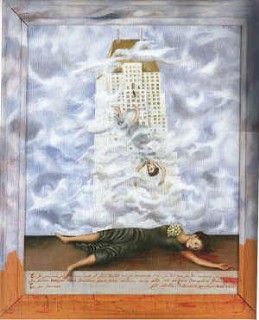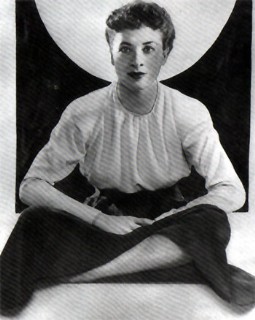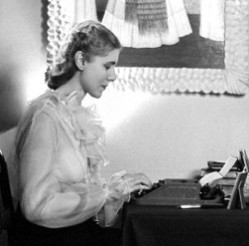The Suicide of Dorothy Hale
1938
This is one of Frida's most shocking and controversial paintings. Frida painted it in the style of an "ex-voto (retablo)". The unfortunate victim in this painting is Dorothy Hale, actress and Ziegfeld showgirl. Hale's life suddenly took a turn for the worse when her husband was killed in an automobile accident. Her Hollywood career was failing, she was in severe financial trouble, and, in the end was living on charity from friends. On October 21 of 1938, wearing her favorite black dress and a corsage of small yellow roses, she jumped to her death from the top window of her luxury high-rise apartment suite.
Clare Boothe Luce, publisher of the fashion magazine "Vanity Fair", commissioned Frida to paint a portrait of her long time friend, Dorothy. The portrait was to be a gift to Dorothy's grieving mother. Frida suggested a"recuerdo" (remembrance) style painting. Although Clare didn't really understand what that was all about, she nonetheless agreed. What Kahlo created was a graphic, narrative "Ex-Voto", detailing every step of Hale's suicide, placing the corpse at the bottom on a stage-like platform in the foreground. At the bottom, blood red lettering details the tragic event:
"In New York
City on the 21st of October 1938, at 6:00 in the morning, Dorothy Hale
committed suicide by throwing herself from a very high window in the Hampshire
House. In her memory [...], this retablo was executed by Frida Kahlo."
When Boothe received the painting she was horrified at what she saw. She was expecting a "portrait" of Dorothy….not a pictorial reenactment of her suicide….and certainly inappropriate as a gift to Dorothy's mother. Her immediate reaction was to destroy the painting but friends convinced her not to. At Clare's request, part of the third line of text that once read "painted at the request of Clare Boothe Luce, for the mother of Dorothy" has been painted over. Another part of the painting was also changed: an angel that once appeared at the top was removed.
At the time this was painted, Frida was separated from Diego and was having her own thoughts about suicide. This painting may be a reflection Frida's compassion for women who are driven to despair by male desertion.
Clare gave the painting to her friend Frank Crowninshield. After Crowninshield's death, it was returned by his son and was not seen for decades. It mysteriously appeared one day at the front door of the Phoenix Art Museum where it is currently on display.

(Click Here to View Larger Image)
(Pinche aquí para ver la imagen aumentada)
Oil
on masonite with
painted wooden frame
23 ¾" x 19"
Phoenix Art Museum
Phoenix, Arizona, U.S.A.
Óleo sobre fibra dura con
marco de madera pintada
60,4 x 48,6
cm.
Museo de Arte de Phoenix
Phoenix, Arizona, EE.UU.
El suicidio de Dorothy Hale
1938
Esta es una de las más impactantes y controvertidas obras de Frida Kahlo. Frida lo pintó como un "ex-voto (retablo). La desgraciada víctima en este cuadro es la actriz Dorothy Hale, actriz y corista de Ziegfeld. La vida de Hale dio un amargo giro cuando su marido murió en un accidente automovilístico. Su carrera en Hollywood no iba bien, tenia muchos problemas financieros y hacia el final dependía de la caridad de sus amigos. En Octubre de 1938, llevando su vestido negro favorito y un prendedor de rosas amarillas, saltó desde la ventana de su apartamento de lujo situado en un rascacielos, falleciendo en el acto.
Clare Boothe Luce, la editora de la revista de moda "Vanity Fair" le encargó a Frida un retrato de su vieja amiga, Dorothy. El retrato iba a ser un regalo para la madre de Dorothy. Frida sugirió el pintar el cuadro como un "recuerdo". Aunque Clare en realidad no entendió lo que ésto significaba, no obstante aceptó. Lo que Kahlo creó fue un gráfico, narrativo "ExVoto", describiendo cada paso del suicidio de Hale, pintando el cadáver en la parte inferior del cuadro, en una plataforma parecida a un escenario. En la parte inferior, Frida explica el trágico evento con letras de color rojo sangre:
"En la ciudad de Nueva York el dia 21 del més Octubre de 1938, a las sies de la mañana, se suicidó la señora Dorothy Hale tirándose desde una ventana muy álta del edificio Hampshire House. En sus recuerdo [....] éste retablo habiendolo ejecutado Frida Kahlo."
Cuando Clare recibió el pintura, estaba horrorizada por lo que vio. Ella esperaba un retrato de Dorothy...no una representación pictórica de su suicidio... lo cual sería inapropiado darle a la madre de Dorothy. Su primera reacción fue pensar en destruir el cuadro, pero sus amigos la convencieron de lo contrario. A petición de Clare, parte de la tercera línea, que una vez decía "pintado a petición de Clare Boothe Luce, para la madre de Dorothy" fue pintada encima. . Otra parte de la pintura también fue cambiada: un ángel que una vez aparecía en la parte superior fue borrado.
Clare
le dio esta pintura a su amigo Frank Crowninshield. Cuando Crowninshield
falleció, su hijo la devolvió y la pintura no fue vista
durante varias décadas. Un día, apareció misteriosamente
delante de la puerta principal del Museo de Arte de Phoenix, donde se
exhibe en la actualidad.

Dorothy Hale - 1930s

Clare Boothe Luce